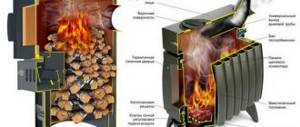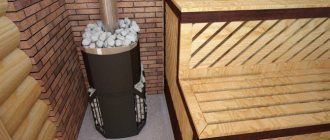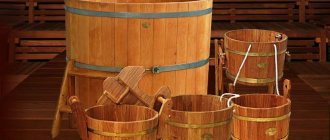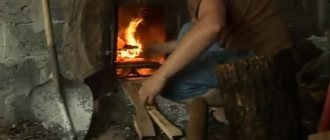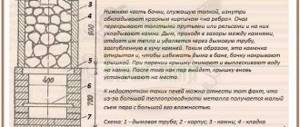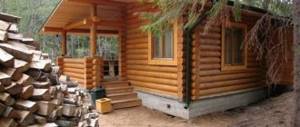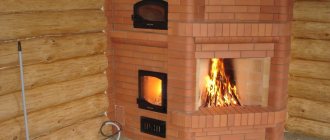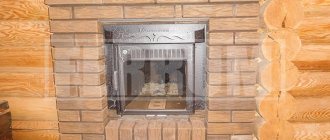If a bathhouse appears in a private house, then an important stage in its arrangement is the installation of heating equipment. A pipe bath stove is an affordable and effective option for organizing reliable heating of a steam room.
Having a working tool and minimal skills in working with welding equipment, a sealed stove structure made of pipes can be quickly assembled at home.
The difference between horizontal ovens and vertical ones
From a space-saving standpoint, it is more profitable to install a vertical structure, but the specific shape of a horizontal oven provides several advantages:
- convenience of fuel loading;
- low stove height and optimal location of the heater box;
- Since in a horizontal stove the fuel is distributed evenly, the wood burns better.
Attention! Because there is better air flow around a round horizontal oven, more heat flows to the water tank and stones.
Modern craftsmen create horizontal structures because many people like the look of such a stove. Due to the simplicity of the design, creating it according to your drawings will not be difficult. Often old natural gas cylinders are chosen to build such a furnace. It is possible to install a piece of pipe from a water supply with a diameter of 50 cm. The most popular design is a horizontal stove made from a 53 cm pipe. Thanks to its horizontal position, it is durable and has optimal heat transfer.
Advantages
When comparing furnaces with different housing arrangements, several distinctive features can be identified that affect the efficiency of air heating:
- Flows of flame and heated gases are directed to the chimney along the shortest path. At the same time, they have less contact with the walls of the structure. The flame flow is located in the very center of the horizontal furnace.
- In horizontal furnaces, flows of heated gases rush to the top of the body. Only then are they thrown out into the chimney due to rarefaction of the air.
- The heat from the heated walls goes normal to them, which means 90% of the heat is radiated in the horizontal direction. Due to this, the walls of the bathhouse quickly warm up. However, the floor receives little heat.
- A stove located horizontally is capable of thoroughly heating all areas of the sauna room, except those adjacent to the floor.
The weight of the structure can be 60-180 kg. For this reason, the horizontal structure is installed in the center of the steam room on a fairly simple frame. If you make 20 mm insulation, the structure can be installed even on a regular 8 mm sheet of steel.
Which one is better to choose?
Regardless of which chimney is used in your steam room, a metal sauna stove with a brick chimney or chimneys for sauna stoves made of stainless steel, their main job is to remove waste gases from the room. Steel pipes are not durable, but they are easy to replace and the price of such parts is much lower than brick ones.
A brick chimney takes up more space, a layer of soot is deposited on it faster, but the level of accumulation and gradual release of heat is higher. Ceramic ones are expensive. Everyone chooses based on their needs and capabilities. The choice of methods is individual, each has advantages and disadvantages.
Construction of a horizontal stove for a bath
The special design of horizontal stoves allows the heater to be heated more efficiently. In these furnaces, the firebox has a tubular shape. Below it are grate bars, usually made of reinforcement or cast iron strips. The water container is placed on the top of the body or at the end. With this arrangement, the water will heat up quite quickly.
Advantages and disadvantages of a pipe bath stove
Pipe sauna stove
- From a physics point of view, the ideal firebox from a thermotechnical point of view is a ball. In this regard, the cylinder is closest to the ideal shape, which cannot be said about products with four sides, for example. Therefore, those who are planning to make a sauna stove from a pipe are on the right track.
- Another important advantage is the absence of seams on the body or the presence of only one seam.
- If we take a pipe of optimal thickness (not too thin and not too thick), we will get an option that will heat up within an acceptable time, and the stove will last a long time.
- Those who use pipes receive stoves that are not too heavy , which can be transported and installed without any problems.
As for the disadvantages, in this case they will be a direct continuation of the advantages of the pipes:
- It is difficult to work with thick metal.
- We need more consumables for tools (grinder and welding machine).
IMPORTANT! However, you will end up with fewer stitches and fewer future problems.
Tools and materials
When creating a horizontal furnace, the following materials are used:
- Pipe section. Its diameter should be from 50 to 53 cm. The length of the body is 80-100 cm. For a steam room of 20 cubic meters. The first characteristic is sufficient. If you need to heat the dressing room as well, it is better to add 15 cm to the pipe length.
- Rectangular sheet of steel 120x70 cm. A small layer of rust is allowed. The main condition is that the surface is smooth, without holes or dents. Metal should be chosen at least 3 mm thick.
- Metal profile. Angle No. 50 is often used. For one horizontal oven you will need 1.5-2 m of profile.
- Reinforcing bars with a diameter of 6-8 mm. You can use cuttings of half a meter.
- The pipe is 150 cm long and 110 mm in diameter. You will also need several knees. The rotation angle and their number should be selected in each case separately.
- Two doors - for the blower and firebox.
- In addition to metal elements, you will need to find 20 electrodes for ferrous and 5 for stainless metal.
- Discs for working with an angle grinder with a diameter of 125 mm.
It is possible to build a horizontal oven only if you use certain tools. The main ones include a welding machine and additional accessories. During the work you will need to saw steel sheets, so you should include a powerful grinder in your list of tools. A carbon dioxide semi-automatic machine is the ideal choice when you need to cook critical components. A simple pulse unit is sufficient if you have the operating skills.
Important! If you choose old pieces of pipes, you should make sure that they do not have any deformations. It's better to use new material.
When installing a horizontal stove for long-term operation in a bathhouse, it is necessary to purchase high-quality pieces designed for medium pressure.
Preparatory stage - selection of drawings, materials, tools
A homemade pipe bath stove is made on the basis of a working drawing, which contains data on the structural elements of the device, and also presents a diagram of its installation. You can develop a drawing of the stove yourself or use a ready-made option.
Without drawing documentation, it is difficult to assemble a structure, since there is a high probability of errors at any production stage, which can lead to ineffective operation of the equipment.
To make a stove with your own hands, you need to prepare:
- a section of thick-walled pipe with a diameter of 500 to 550 mm, a thickness of 8 to 15 mm, length - up to 150 cm (for the combustion chamber and water tank);
- a piece of steel pipe with a diameter of 310 to 340 mm, thickness up to 8 mm (for a heater);
- pipe section with a diameter of up to 150 mm, thickness from 2 to 5 mm (for chimney);
- sheet metal up to 12 mm thick;
- ready-made grate or metal rod (for self-production);
- doors for the main cameras or metal (for a homemade model);
- heavy garage door hinges (for homemade doors);
- welding equipment (manual or semi-automatic);
- grinder with circles for cutting and cleaning;
- electric drill;
- locksmith tool.
Stove design with horizontal firebox
Most horizontal ovens have an identical design. There may be slight differences depending on the version - the location of the water tank and the design of the ash pan. Before work, you should compare different projects and study the drawings.
The location and parameters of the grate are of great importance for the efficient operation of a horizontal furnace. If you make them too wide, traction will be reduced. The width of the grate should not be more than 12 mm. They should be located along the entire length of the combustion chamber.
When choosing between steel and cast iron grates, you should give preference to the latter. Such elements will last much longer. To prevent clogging of the suction with ash, the ash pan is welded in the form of a separate box. It is connected from below.
Often the window for loading fuel is made in the form of a box tunnel. Thanks to this, it is possible to open the firebox and vent doors into the utility room. This eliminates the appearance of dirt and cinders from the washing room.
The heater box is installed on top of the structure, closer to the chimney. The front of the body is always colder. Often it only serves to heat the air in the room. In some horizontal stoves, the chimney outlet is bent. This allows you to increase the contact area with stones and the water tank.
Design features and types of furnaces
The sauna stove structurally consists of the following elements:
- Ash pan. It is located under the combustion chamber and is intended to collect ash after combustion of fuel material.
- Blower. A protective door that provides natural air circulation in the combustion chamber for better combustion.
- Firebox. It is intended for loading and combustion of fuel, as a result of which the room is heated and water is heated.
- Grate. Divides the combustion chamber into two compartments, the upper one for loading and burning fuel, the lower one for collecting ash.
- Furnace heat exchanger. Built into a chimney or fuel chamber for heating water and heating.
- Chimney pipe. Used to remove exhaust gases released during combustion of fuel material.
- Gate valve for smoke exhaust. Designed to create natural draft in furnace equipment. The intensity and rate of combustion of the fuel material depends on the size of the valve.
According to the type of fuel used, modern heating stoves for baths are:
- Wood-burning. The simplest and most durable version of a stove structure made of brick, stone or metal. Such devices provide fast and efficient heating of rooms of any size. Firewood, pellets, briquettes and solid fuel material can be used as fuel.
- Gas. Devices with a constant heating function operate on natural gas or liquid fuel. Provides fast and uniform heating of rooms in a short period of time.
- Electric. Such units differ in size, operating power and functionality. Electric ovens are capable of maintaining high temperatures. Despite their practicality and durability, they are quite energy-intensive, so they are suitable as an additional source of heating.
Furnace assembly
A hanging container for water and a compartment for the heater are installed on the horizontal structure. This stove is quite compact, and by increasing the depth of the firebox, the room is heated faster. When manufacturing a structure, a number of sequential actions should be performed:
- A piece is cut out of a steel pipe, measuring a length of 80 cm. The edges should be carefully aligned and cleaned.
- Weld the grate. To make the platform correctly, a rectangular piece of 80x40 cm is cut out of a 1.2 cm metal sheet. A hole is made inside, leaving only the frame. Reinforcing bars are welded to it. Finished products are sold at any hardware store.
- Weld the grate platform into the body. The seam of the body pipe should be located above the grates. They heat up more, which ensures greater heat transfer from a horizontal oven.
- A façade of 0.6x0.7 m (width and height, respectively) is created from a steel sheet. Its top is made rounded. It creates 2 rectangular cutouts for the doors.
- The dimensions of the rear element of the housing differ from the dimensions of the facade. They are equal to 0.7x0.9 m. This element on top will limit the compartment for stones.
- The rear element and facade are welded to the body. A restrictive grid for the heater is installed in the center of the structure.
- The rear element with the facade is welded to the body. A front limiter for the stone compartment is installed on top.
- A hole is cut in the upper part of the stove to install the chimney pipe. It is better to make it 15x15 cm in size. Then install the furnace roof.
- A chimney is welded to it. The arch will also serve as the bottom of the compartment for stones. A grid 20 cm high is installed on the walls of the vault.
- Install the doors. Clean the stove with a grinding wheel to get rid of rust, and then treat it with heat-resistant paint. First, the oven is heated outside to bake the paint.
- Install a water tank on top of the rear part. To do this, weld a shelf equal in size to the bottom of the water container. When laying the heater with stones, they should be laid with flat surfaces as close as possible to the metal walls. This will make the stones heat up faster.
Taking into account the features of each stage, it will be possible to assemble an effective and durable structure.
Manufacturing a vertical furnace from steel pipe
Vertical steel pipe furnace
Pipe stove
The process will use a 1.5-meter pipe Ø 50 cm, the wall thickness should be at least 1 cm. The algorithm of actions is as follows.
Scheme of a pipe stove
Step 1. First, the pipe is cut into two parts - 90 cm and 60 cm. The smaller part will serve as a container for water (by the way, the diameter of this section may be smaller), and the larger part will house a firebox with a heater.
Pipe marking
Step 2. A rectangular cutout for the blower is made at the bottom of the larger segment. The height of the hole should be 50-60 mm, and the width should be 180-200 mm. The ash pan itself, by the way, will also serve as an ash pit.
Cutting a pipe - hole for the blower
Step 3. A round steel plate with a thickness of 12 mm and a diameter corresponding to the internal diameter of the pipe used is welded above the blower hole. A hole for the grate is cut in the center of the circle. It’s easier to buy and install a ready-made “store-bought” grate, but if you wish, you can do everything yourself - weld reinforcing bars onto the hole in the form of a lattice, but so that the gaps between them correspond to their diameter.
Fabrication and installation of steel plate
Step 4. A niche measuring 300x250 mm is cut out for the combustion chamber (there should be approximately 50 mm left to the bottom of the chamber). Then a pair of hinges are welded, and a pre-cut door of the appropriate size is hung on them. A latch is attached to the door.
Manufacturing and installation of the door
Note! If the firebox needs to be moved into an adjacent room, then you can weld a special rectangular apron around the door with a distance of 50-100 mm from it (the door) on each side.
Step 5. Next, a cutter is made above the combustion chamber - a rectangular steel sheet with cut corners. Through these cut corners the sheet is welded to the body. The gaps remaining between the sides of the sheet and the walls of the pipe are sufficient for the passage of smoky gases. This will promote the movement of smoke along the walls of the pipe, due to which they will warm up more intensely.
We weld the cutter inside
Step 6. Above, approximately 70-100 mm from the cut-off valve, a grille made in advance from reinforcing rods Ø 1.2-1.5 cm is welded to the body. This grille will serve as the bottom of the heater. The heater door is installed so that a person can easily open it from the steam room. The manufacturing technology here is the same as for the firebox door.
Step 7 . The top of the housing is welded with a steel sheet with a hole made in it (the diameter of the latter must correspond to the diameter of the prepared chimney pipe).
We weld the steel sheet in which the lid will be installed
Step 8 . As noted above, a section of the same pipe that was used for the body can serve as a water tank (if desired, the tank can be made of sheet steel). It is important that the bottom of this tank is made exactly the same as the top of the heater. Using a welding machine, a pipe is attached to its bottom - it will pass through the center of the entire tank and protrude from the top by about 350-400 mm.
It is also necessary to install a lid on the tank, made in the form of a semicircle. To do this, the piece of steel that will cover the tank is cut into two parts. One of them is welded, and the other is attached to the first using hinges - this will be the semicircle cover.
Hinged lid
Step 9. A tap is installed at the bottom of the tank to drain the water.
Connection pipe for tap
Note! All that remains is to weld the gate to the chimney pipe, about 30 cm from the water tank.
Shiber
For this design, you can make a remote firebox. It is necessary to cut a sheet of steel, perform cutting and welding. The stages are shown in the photo.
Stages of manufacturing a remote firebox
Bath stoves made of pipe and steel. The design of the stoves is the same - it is a body divided into a water tank, a heater, a firebox and an ash pan. Steel sheets and gratings are used for separation. A chimney pipe is routed from the firebox through the tank and heater
Video - Making a stove from a pipe
Video - Vertical pipe stove
Requirements for installing the stove
The rest of the furnace installation work is carried out in accordance with the following requirements:
- Mount the stove on a pre-created base. It is installed twenty centimeters from the wall.
- In the place where the chimney will be vented outside, a thickening of 120 mm is created.
- The pipe between the ceiling of the bathhouse and the roof is treated with lime.
- The height of the part of the pipe that will protrude above the roof should be at least half a meter.
- The shelf must be installed next to the wall where the stove is located. The person sitting on it should not reach his head to the ceiling.
Such conditions allow you to install the stove in the bathhouse more rationally, without making common mistakes.
When creating a stove from a pipe, you can make a mistake. As a result of an oversight, the design will not function effectively enough. Therefore, in the process of creating a stove, you should consider some tips. For example, installing a movable valve in the chimney pipe will help prevent the rapid blowing of heat out of the structure.
When a lot of soot accumulates, it can catch fire. To prevent this situation, it is worth equipping a horizontal furnace with an afterburner. For this purpose, two holes are made in a certain section of the pipe wall, into which metal tubes are subsequently installed, bent towards the pipe. This eliminates the formation of soot. As a result, more oxygen will enter the firebox, and the wood will burn out completely.
Taking these tips into account, you can assemble a stove that can effectively heat a bathhouse. At the same time, not much firewood is consumed. The volume of the water tank depends on the features of the housing.
A sauna stove made from a pipe - what's good about it?
Without getting lost in thought, let’s immediately list all the specific advantages of a homemade iron stove made from a pipe:
- cost: as mathematicians say, the price of a homemade heater tends to zero and depends on the availability of certain materials. But even if you have to buy them all and order the welding work from a master, the product will still cost half as much as a factory stove from a store;
- easy to make with your own hands: in fact, a pipe with thick walls is a ready-made heater body;
- the cylindrical shape of the firebox is considered optimal from the point of view of combustion theory;
- dimensions, configuration, service life - all this is in your hands. If you want an eternal stove, take a pipe with a wall of 10 mm; if you want to burn meter-long logs in it, please make a firebox of the appropriate size.
Advice. If you are starting to make a sauna stove for the first time, then it is advisable to take as a basis a ready-made drawing, according to which working copies have already been made, or to weld the heater according to an existing model. There are a huge number of them on the Internet.
By and large, homemade metal sauna stoves come in two types – vertical and horizontal. The former take up less space, but for them you will have to prepare the firewood shorter, and add it more often. A horizontally located pipe allows you to load more long logs into the firebox, which will increase the burning time. As for efficiency, it practically does not depend on the orientation of the pipe. As information for reference, it can be noted that the efficiency of such units does not exceed 50%.
conclusions
The level of tilt of the body does not affect the operation of the stove. Therefore, you can install it arbitrarily. It is possible to treat the chimney with a high-temperature compound. This will help eliminate the metallic smell. After several fires, the pipe burns out and turns red. No further oxidation of the metal occurs.
As you can see, you can build a horizontal stove for a bathhouse yourself, if you get acquainted with the main stages of work and the features of preparation. It is important to choose the right materials and find all the necessary tools. If you have basic welding skills, you can make an effective structure that will last for decades.
Recommended Posts
DIY cellar
Wall mounted metal shelves
How to make a birdhouse with your own hands
How to make a swing nest with your own hands
How to make a cellar lid with your own hands
How to make a fountain in your country house
